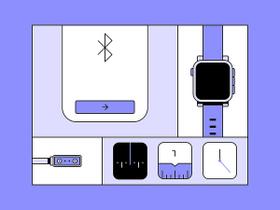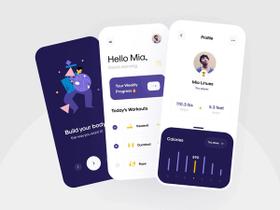In the rapidly evolving world of wireless communication, Bluetooth technology is a pivotal innovation, enabling seamless connectivity across multiple devices. However, with the advent of Bluetooth Low Energy (BLE), businesses often wonder which technology best suits their needs. Although both fall under the Bluetooth umbrella, they serve distinct purposes.
This article aims to clarify the difference between Bluetooth and Bluetooth Low Energy. It will examine the enhancements made in Bluetooth 4.0 and Bluetooth 5.0, explore their features, and discuss their use cases. By understanding the strengths and limitations of each, you can make informed decisions about which technology aligns with your specific requirements - whether it's BLE integration or custom kiosk software development - and when to partner with a BLE app development company for your project.
Let’s go! 🚀
📚 The Concept of Bluetooth Classic
Bluetooth Classic, officially known as Bluetooth Basic Rate/Enhanced Data Rate (BR/EDR), is a well-established wireless technology designed to handle continuous, streaming data over short distances using short-wavelength radio waves. It excels in scenarios where high throughput and sustained connections are necessary.

Bluetooth Classic supports high-quality audio streaming between devices over short distances (image by Dmytro Sobkovich)
Key features of Bluetooth Classic include:
- Higher Data Rates. It operates in the 2.4 GHz ISM band and supports data rates of up to 3 Mbps, making it suitable for applications requiring robust data exchange, such as audio transmission and file sharing.
- Voice and Audio Support. This technology is optimized for transmitting audio data, making it ideal for wireless headphones, speakers, and hands-free devices.
- Support for a Wide Range of Devices. Bluetooth Classic is supported by a vast array of devices, such as keyboards, mice, game controllers, and other input devices ensuring compatibility and ease of use across different platforms.
The Advantages and Limitations of Bluetooth Classic
Like any other technology, Bluetooth Classic has its advantages and disadvantages. Let’s take a closer look at them.
Pros
- Higher Data Rates. It supports data rates up to 3 Mbps, ideal for high-quality audio streaming and data-intensive applications.
- Robust Audio Support. It’s optimized for continuous audio transmission, ensuring high-quality sound for wireless audio devices.
- Wide Compatibility. Bluetooth Classic is supported by a large number of devices, ensuring broad compatibility and user convenience.
- Established Technology. It’s well-established with a proven track record, ensuring reliability and stability in various applications.
- Enhanced Data Security. It offers robust security features, including device authentication and encryption.
Cons
- Higher Power Consumption. It consumes more power than BLE, which leads to shorter battery life in portable devices compared to BLE.
- Limited Range. Bluetooth typically operates effectively within a range of around 30 meters, which can be limiting for certain use cases.
- Not Ideal for IoT. Due to its higher power consumption and other limitations, it is less suited for IoT applications compared to BLE.
Bluetooth Classic remains a cornerstone in wireless communication, particularly in applications requiring continuous data transmission and robust audio support. However, Bluetooth's higher power consumption and limited range present challenges, particularly in modern IoT applications. In contrast, BLE often becomes a more suitable choice, like in IoT in healthcare from clinics to mobile apps.
📘 The Concept of Bluetooth Low Energy
BLE, introduced as part of the Bluetooth 4.0 specification in 2010, is a wireless communication technology that provides reduced power consumption and cost, which can significantly influence IoT project cost estimation, while maintaining a similar communication range to Bluetooth Classic. This innovation caters specifically to the growing demands of modern applications, especially in the realms of wearable devices, smart homes, and the IoT.
BLE operates in the same 2.4 GHz ISM band as Bluetooth Classic but employs a different modulation scheme, allowing for low energy consumption, which is particularly beneficial in IoT for factories where energy efficiency and cost reduction are critical. This technology is optimized for the periodic transfer of small amounts of data, making it ideal for devices that require long battery life and intermittent communication.
Our developers working on BLE connection in Android consider connection states, advertisement intervals, and reconnection strategies to optimize power efficiency and maintain a reliable connection.

BLE technology improves the connectivity of smart home devices, making it easier to control and monitor them seamlessly from mobile devices (image by Paweł Samczuk)
Key features of Bluetooth Low Energy include:
- Low Power Consumption. BLE vs Bluetooth consumes significantly less power, enabling devices to run on small batteries for months or even years. This efficiency is achieved through short, efficient communication bursts and long sleep periods.
- Efficient Data Transfer. It is suitable for transmitting small amounts of data periodically, which is common in sensor and beacon applications.
- Scalability and Flexibility. BLE supports a wide range of stateful applications, from simple data broadcasting to complex mesh networks. Additionally, the Bluetooth 5.2 update introduced LE Audio, which enables the transmission of audio over Bluetooth Low Energy vs Bluetooth Classic. This update provides new features like multi-stream audio and broadcast audio, paving the way for more advanced and versatile audio applications.
- Fast Connection and Communication. BLE offers rapid connection establishment and data transfer, enhancing user experience in various applications.
- Robust Security. BLE includes advanced security features such as AES-128 encryption and secure connections, ensuring data integrity and privacy.
The Advantages and Limitations of BLE
BLE technology offers various advantages and certain limitations that are crucial to understanding its effective utilization in modern applications. Let’s examine them.
Pros
- Broad Range of Applications. BLE is compatible with various products, from health and fitness devices to smart home applications and asset tracking.
- Long Battery Life. BLE devices can run for years on small batteries, making them perfect for wearable tech, health monitors, and other battery-dependent devices.
- Fast Pairing and Connection. BLE devices can connect quickly and efficiently, ensuring a smooth user experience.
- Cost-Effective. The low power and low data rate features of BLE contribute to lower overall costs, making BLE an economically viable solution for many applications.
- Flexible and Scalable. It supports various network topologies, including point-to-point, star, and mesh configurations, making it highly adaptable.
- Improved Privacy and Security. BLE incorporates robust encryption and privacy features to safeguard data transmission.
- Increased Range. Bluetooth LE vs Classic can range up to 100 m in Bluetooth 5 and newer versions.
Cons
- Lower Data Speed. BLE vs Bluetooth Classic supports lower data rates of 1-2 Mbps, limiting its use in applications that require high throughput, such as high-quality audio streaming.
- Less Suitable for Continuous Data Transfer. BLE's design focuses on intermittent data transfer, making it less ideal for applications requiring continuous data streams, such as real-time audio or video transmission.
BLE stands out as a pivotal technology in wireless communication, particularly for those looking to create wearable device apps where power efficiency and long battery life are paramount. If you’d like to learn more about BLE from the perspective of our CTO, Oleksii Bulavka, you can read his recent Bluetooth Low Energy guide.
⚖️ Technical Comparison of Bluetooth Classic and BLE
As you see, Bluetooth and BLE are multifaceted technologies. Let’s make a comparison Bluetooth and Bluetooth Low Energy tech protocols to understand their differences with the help of our React Native Developer, Dmytro Zasukha.
Tech Characteristics | Bluetooth Classic | BLE |
|---|---|---|
Frequency Spectrum | 2.4GHz | 2.4GHz |
Data Rate | 1–3 Mb/s | 125 Kb/s – 2 Mb/s |
Number of Channels | 79 channels with 1 MHz width | 40 channels with 2 MHz width |
Connection Range | 10–30 m | 10–30 m (in ideal conditions — up to 100 m) |
Latency (non-connected -> connected state) | 100 ms | from 6 ms (depending on connection interval) |
Topology | Point-to-Point (1:1) | Point-to-Point (1:1) |
Security and Encryption | 64b/128 bit | 128-bit AES |
When comparing BLE and Bluetooth, it’s also important to consider how the Web Bluetooth API can enhance device connectivity. To sum up the following table, the lower latency, more versatile network topologies, and enhanced security of Low Energy Bluetooth compare to Classic which provides higher data rates. Still, both technologies have found their places in various domains, where developers leverage their strengths for efficient and effective wireless communication solutions.
Exploring ANT vs Bluetooth further reveals how ANT excels in ultra-low-power use cases, while Bluetooth offers broader compatibility.
🗂️ Use Cases of Bluetooth Classic and BLE
With its versatile applications, Bluetooth technology is an integral part of our connected world. The 2024 Bluetooth Market Update report by SIG (Special Interest Group) provides us with the following numbers on BLE and Bluetooth smart devices:
- 1.01 billion Bluetooth audio streaming devices are expected to ship in 2024.
- 648 million Bluetooth wearables will ship in 2024.
- 35 million Bluetooth health and fitness trackers will ship in 2024.
- 675 million Bluetooth smart home devices will be shipped in 2024.
- 107 million Bluetooth asset tracking devices will ship in 2024.
Indeed, BLE vs. traditional Bluetooth has distinct characteristics that make them suitable for a range of use cases, from wearables to farming IoT devices. Let’s discover the most popular applications of each technology.
Technology | Use Case | Examples |
|---|---|---|
Bluetooth Classic | High-quality Audio Streaming | Wireless headphones, speakers, car audio systems |
Wireless Peripheral Connections | Keyboards, mice, game controllers, printers | |
BLE | Health and Fitness Monitoring | Fitness trackers, heart rate monitors, medical smart devices |
Smart Home Devices | Smart locks, light bulbs, thermostats | |
Asset Tracking | Beacons, tags, location trackers, industrial labs | |
Wearables | Smart glasses, smartwatches, smart clothing | |
IoT Devices | Sports equipment | |
Audio Streaming | LE Audio (since Bluetooth 5.2 update) | |
Robotics | Robots, such as RVR+ and Sphero BOLT |
Up to this day, Bluetooth and BLE aren’t mutually compatible. Therefore, the Bluetooth 4 update introduced Bluetooth dual-mode devices to bridge the Bluetooth vs BLE gap. They support both technologies, providing the best of both worlds. According to the SIG Bluetooth Market report, all new platform devices will have dual-mode Bluetooth by 2024.

When you look at dual-mode Bluetooth versus the Bluetooth Classic, you see that dual-mode works better. It connects more easily to different gadgets like iPhones and Android phones, and anything that needs to send a lot of information back and forth. So, if you need a strong link to many different devices, dual-mode Bluetooth is your best choice.
Dmytro Zasukha, Android | React Native Developer @ Stormotion
With dual-mode support, devices can switch between BR/EDR for high-speed data transfer (e.g., audio streaming) and BLE for low-power applications (e.g., sensors, wearable devices). This flexibility optimizes power consumption while maintaining connectivity.

Dual-mode Bluetooth ensures seamless integration of smartphones with car infotainment services (image by Hemant Bisht)
Here are some use cases of dual-mode Bluetooth with examples:
- Smartphones and Tablets. They support both Bluetooth Classic for high-quality audio streaming to headphones or speakers and BLE for energy-efficient communication with fitness trackers or smartwatches.
- Home Automation. Smart locks utilize Bluetooth Classic for secure, close-range unlocking and BLE for remote monitoring and battery status checks via a mobile app.
- Automotive Application. A car infotainment services support Bluetooth Classic for hands-free calling and streaming audio from smartphones, and BLE for transmitting vehicle diagnostic information to a mobile app, illustrating key approaches to connected car app development.
- Gaming and VR. VR headsets and gaming controllers employ Bluetooth Classic for responsive gameplay and BLE for power-efficient communication with companion apps or secondary devices.
To sum up, Bluetooth Low Energy vs Bluetooth has unique protocol features that cater to specific use cases. Dual-mode devices offer a flexible solution that bridges the gap between these two technologies.
🔎 Our Expertise in BLE Integration
Stormotion team has a long track record of cases with BLE integration in various spheres, such as EV companion applications, fitness apps, and e-mobility apps. Let’s see how our team has helped the clients to reach their goals.
One of the most recent examples is Egret, a leading e-scooter manufacturer, which faced inconsistent Bluetooth connectivity across different scooter models. The IoT application development process involved reverse engineering the existing protocol and creating a generic protocol handler to ensure BLE connectivity with all scooter models. Now, users can set up and control their e-scooters via a user-friendly app.

The user-friendly design of Egret allows users to connect and monitor their e-scooters via BLE modules (image by Stormotion)
If you’re thinking about integrating BLE in your React Native app, we can tell you about our case with the EV companion application. We created the Norsk Guardian app for a company producing lithium-ion batteries for boating activities.
The development process involved thorough testing, BLE module creation for data transfer, and leveraging the React Native framework for app development (which can also be applied when you want to develop a BMS software for real-time monitoring of battery systems). As a result, the app monitors multiple battery parameters such as temperature, voltage, and charge levels via unique BLE modules, ensuring safe water trips.

The Norsk Guardian app monitors crucial battery parameters for safe boating with lithium-ion batteries (image by Stormotion)
This video testimonial highlights the client’s perspective on our work with Norsk Guardian:
The other notable example is SportPlus. Our task was to develop a mobile app that seamlessly connects with workout equipment. The main challenge was determining how to integrate BLE fitness devices into app and manage the inconsistent communication protocols across four different BLE standards. To address this, the team created a generic protocol handler. Now, the app facilitates smarter, data-driven workouts, helping SportPlus leverage modern technology in the fitness industry.

SportPlus enhances fitness routines overcoming the challenge of integrating multiple BLE fitness devices into the app (image by Stormotion)
💡 Takeaways
Let’s conclude the comparison of Bluetooth Classic and BLE technologies:
- Both technologies operate within the 2.4GHz spectrum with similar connection ranges, and security protocols, yet their distinct features cater to diverse needs across industries from healthcare to IoT.
- While Bluetooth Classic excels in high-speed, continuous data applications such as audio streaming and peripheral connections, BLE offers significant advantages in power efficiency, making it ideal for IoT, wearable devices, and other battery-dependent applications.
- The evolution towards dual-mode devices underscores a hybrid approach that leverages the strengths of both technologies, ensuring optimal performance and flexibility in wireless communication solutions.
If you have questions about implementing Bluetooth or BLE into your project, write to us! Whether you're looking to optimize power efficiency with BLE or achieve seamless audio streaming with Bluetooth Classic, we're here to help!


![Stormotion client Max Scheidlock, Product Manager from [object Object]](/static/33294af91c38256bcd5a780ddc41861a/b0e74/max.png)





